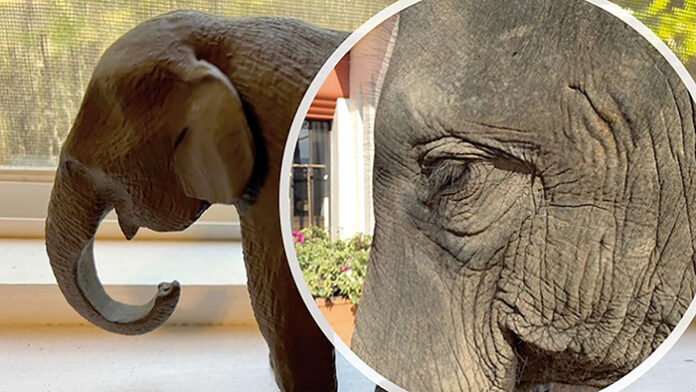This is a picture of an elephant walking along my windowsill.
Even though this elephant is stationary and made of clay, it reminds me of elephants grazing in Thailand. The soft light created by a dusty screen produces a haze similar to the jungle-like mist of elephants’ natural habitat.
For nine weeks, while at yoga training in Khao Lak, two hours south of Phuket, I glimpsed a lone elephant wandering freely in the palm plantation surrounding camp.
As magical as seeing that lone elephant was, in Chiang Rai, I met several elephants at an eco-rescue-resort. The baby was able to fit in the outdoor dining area, joining us for breakfast. Looking into their eyes is to be smitten. Such a magical moment. Lovely to have this memento in a location that recalls their noble souls and a wonderful adventure.
Fun facts: Elephants have been in Thailand for 16 million years. At the turn of the prior century, there may have been as many as 250,000; today there are only approximately 5,000 elephants, half of them domesticated and half of them wild. A domesticated elephant is paired with a mahout—trainer and caretaker—for respective lifetimes.
Asian elephants (Elephas maximus) live about 40 years in the wild, spending about 18 hours a day eating, chomping 450 pounds of vegetation, requiring 40 square miles of forest range. They drink about 50 gallons of water in a day. Asian elephants may weigh over 10,000 pounds and stand 10 feet tall.
An elephant’s foot has a deep pillow-like consistency, allowing it to walk over smaller rocks without overbalancing; the foot cushion simply “absorbs” uneven surfaces. Its thick skin, with wrinkles and folds, helps it diffuse heat, like a radiator’s fins. An elephant’s trunk fuses nose and upper lip; its sense of smell is extraordinary.
All wild elephants are protected property of Thailand and are its national animal. Elephas maximus is classified as an endangered species.








